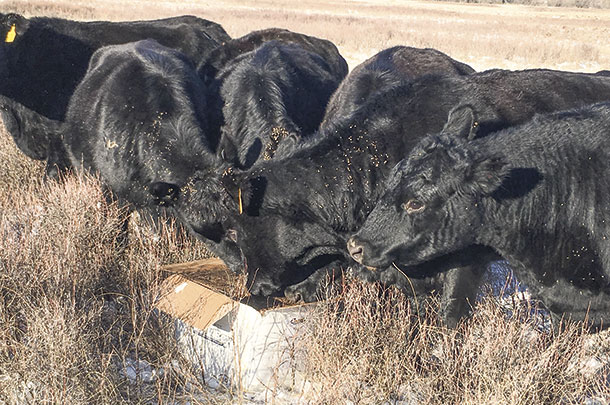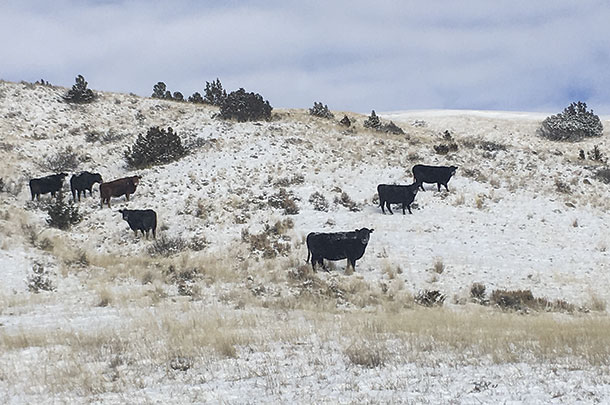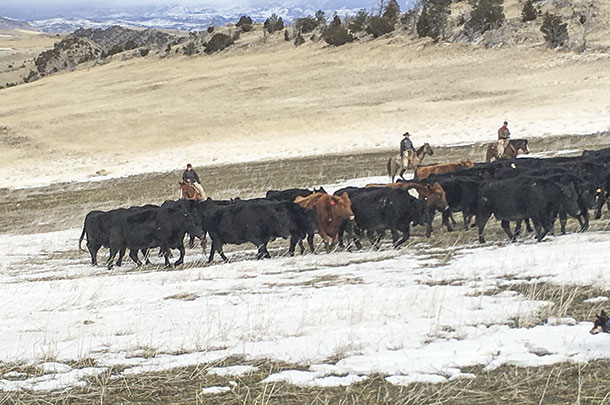For the commercial cattleman wanting to buck the trend of feeding hay all winter and calving in the winter months (a trend set when feed, labor, fuel and equipment were all much cheaper), there’s the option of ranging cattle out during the winter and calving in spring on green grass. But with this option, there are some things we need to keep in mind.
First is: There are those who will say it can’t be done “because we get snow here” or “cattle can’t meet their requirements without extra hay during the winter.”
Well, they only say that because they can’t do it. When someone tells me I can’t do something, I hear a challenge I have to overcome.
As for cow requirements, many of them are simply the requirement for the average cow. I would argue if we keep average cattle around, then we won’t stay in business too long. After years of winter-ranging cattle and listening to people say it couldn’t be done, I have found some things critical to consider.
I was forced to rethink how I see the availability of feed and water, and that constant movement of stock is a must.
A matter of how much
Volume of feed available is critical. If you live in snow country, there will be feed that does in fact get frozen to the ground or trapped in an ice block the cattle simply can’t get to. As a result, stocking rates can’t be calculated like you would in spring and summer ranges. And I have found if you assume half of what would be available in the summer months, volume of feed is rarely an issue.
Of course, every year and every operation is going to vary. Webster’s original dictionary defined agriculture as the practice, the science and the art of raising food and fiber for human consumption. Well friends, winter-ranging is an art at times.
Supplements and protein
If volume of forage is available, energy abounds for the cattle, but protein on winter range in our county is generally around 4 percent, a far cry from desirable. Every cow type will have different energy and protein requirements. But as a rule, the bigger the cow, the bigger the requirement, which is why more moderate-sized cattle are desirable if you choose to graze out the winter.
People have their preferences on protein supplements, and none of them are really wrong. Be sure to calculate the cost of getting the feed to the animal (labor, time, fuel, wear and tear on trucks, etc.) in addition to just the ration cost.
We use hard protein blocks on our operation (Photo 1), as we have many miles to travel in the back country to where our cattle range and can’t use supplements that require every-other-day feeding.

We place protein in different locations each week to keep cattle in areas of greatest forage availability.
Most of the cattle will follow the truck to the supplements, but after the blocks go out, we mount up and trot a circle to gather outlying cattle onto the blocks. This forces us to be out in sometimes less-than-ideal weather but also allows us to get a good look at the cattle.
A fringe benefit is: It seems to keep the cattle gentle, and they stay used to being herded throughout the year and get used to being settled in different areas. By spring, our forage utilization is surprisingly even throughout the winter pastures.
Water and snow
Water is the second-greatest concern, though neither more or less important than forage availability. Water does not always have to come in liquid form, though that is much preferred.
There has been research conducted in Montana, the Dakotas and Canada on utilizing snow to meet water requirements and it seems to indicate cattle can adequately meet water needs. We have even had cattle prefer to eat snow rather than wade into cold water to drink from rivers and streams.
There are some nay-sayers out there who say cattle have to eat so much snow to meet their requirement it drops their core temperature, which results in fat loss and poor performance. Let me point out a few observations in this area.
First, cattle don’t eat ’til they’re full and then go eat snow for four hours to meet their water needs. If you watch cattle grazing winter range, you will notice they eat a couple of bites of grass and then lick the snow. By doing this over the day’s grazing, they don’t ingest enough snow at one time to upset their thermal state of happiness.
There are different types of snow stockmen need to be aware of, however. Dry, fluffy snow will not have the moisture in it heavy, large flakes do. Often, underneath crusted snowdrifts will be high-moisture reservoirs of snow that can be accessed once the crust is penetrated.
It is common knowledge that, unlike horses, cattle don’t have the instinct or ability to paw at crusted snow to get the forage underneath, but this doesn’t mean cattle are helpless. If they can get through the crust of thick snow, they can and will pop the crust from underneath and graze and lick snow happily and efficiently.
If their noses are down and white with snow, it is a good indicator they are grazing and taking in snow for moisture (Photo 2).

Grazing behavior
Constant movement of the herd and monitoring behavior (Are they bawling, hunched up or moving freely and grazing?) will greatly increase success of winter grazing. Moving salt, mineral and protein sources on a regular basis to areas of heavier forage concentration will change movement patterns of the stock, resulting in hooves breaking through the top crusted layer of snow, revealing forage below.
We have gone so far in heavy snow years as to rodear cattle in areas of deep snow we knew held large volumes of grass beneath it. In short order, grass is revealed underneath, heads go down to graze and, before long, cattle are plowing up snow and grazing where they normally wouldn’t without extra herding.
Snow will get soiled in short order when cattle are bunched tightly, thus requiring a move to a fresh area (Photo 3).

Winter grazing is a combination of science, practice and art. Every year will be different and require new and innovative ideas. It does require more diligence in monitoring cattle for body condition, herding to fresh grass and snow, but it almost every time results in large decreases to the feed bill. ![]()
PHOTO 1: Obviously, these cattle have been foraging through some burrs, but the protein blocks are helping to keep them in good flesh. Note their coats look shiny, eye expressions look healthy, and they are aggressively consuming protein blocks. All are signs of healthy cattle faring well on winter range and snow.
PHOTO 2: Cattle winter graze on native range. Note all cattle are in good flesh, have snow on their muzzles from grazing snow and forage at the same time.
PHOTO 3: Herding to fresh forage and snow is a constant in winter. Utilizing snow to meet water requirements allows for grazing of areas that can’t be grazed at other times of the year due to lack of drinking water on this operation. Photos provided by Billy Whitehurst.

-
Billy Whitehurst
- Makale Livestock
- Whitehall, Montana
- Email Billy Whitehurst









